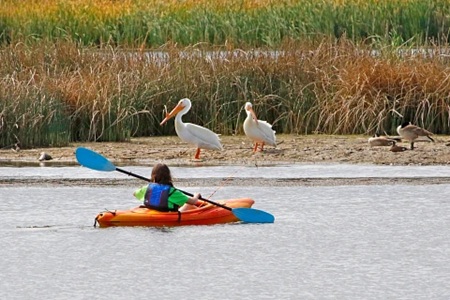Our series exploring Colorado’s state parks continues with St. Vrain! St. Vrain State Park is a wonderland for water-lovers, providing access to wetlands, rivers, and 11 distinct ponds.

St. Vrain is located near I-25 between Denver and Fort Collins. It features 228 acres of water across several ponds, each with their own characteristics and unique fish populations. While exploring all the fishing options in the park, anglers might find bluegill, largemouth bass, channel catfish, crappie, and rainbow trout. Outside of the water, visitors can spot several species of migrating birds, along with the birds that make St. Vrain home; the largest body of water is aptly named Blue Heron Reservoir because of the significant population of Great blue herons nesting along the shore.
The history of St. Vrain is closely linked to the history of I-25. In the late 1950s, the Colorado Department of Transportation purchased land along St. Vrain Creek to mine gravel needed to build Highway 87 (a precursor to I-25). After the completion of the highways, the leftover gravel ponds were given to the State Parks Department to create a recreation area originally named Barbour Ponds. By the 1960s and 70s, the park had become so popular that campgrounds, bathrooms, picnic areas, and nature trails were built among the ponds. Construction on I-25 sparked more investment in St. Vrain in the early 2000s, adding five more ponds to the network and restoring the riparian area along surrounding creeks and rivers. The most recent addition, Blue Heron Reservoir, was completed in 2015 for St. Vrain’s 50th anniversary.
The St. Vrain Creek feeds into the park’s ponds, and the surrounding St. Vrain watershed plays an important role in Colorado’s Resiliency Framework. The Resiliency Framework is a statewide plan that aims, in part, to improve Colorado’s ability to adapt to climate change and natural disasters. As part of the larger framework, the Resilient St. Vrain Project (RSVP) was implemented to address St. Vrain Creek’s susceptibility to flooding, which was made apparent in 2013 when devastating floods damaged hundreds of homes, businesses, and public lands. While the plan is still in progress, the RSVP team has used natural design techniques to rebuild and improve the creek’s banks and protect the natural wetlands that help filter water during heavy rains. Updates to the RSVP, and other projects managed by the Colorado Resiliency Office, can be found in the yearly Resiliency Framework implementation progress report.
- Colorado state parks: St. Vrain - August 8, 2025
- Peach production in Colorado - July 25, 2025
- Colorado’s Governors: Ralph L. Carr - July 11, 2025